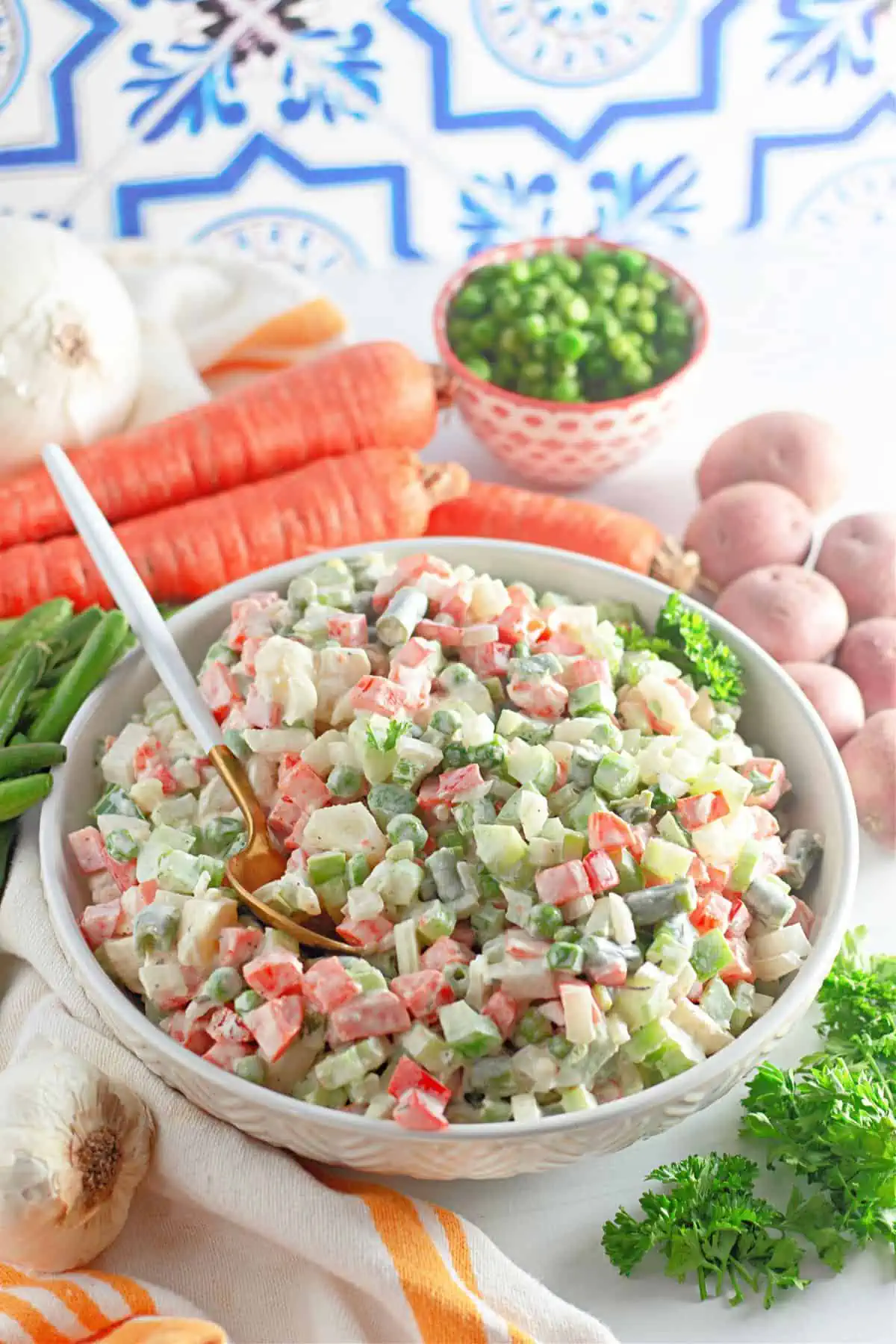We may earn income from links in this post. Please read this Disclosure for details.
This chilled Ensalada Rusa or Russian Salad recipe is a popular side dish for every occasion in Guatemala from a churrasco (barbecue party) to Christmas holidays and everything in between.
It’s an easy chopped vegetable salad made with tender potatoes, carrots, peas, and green beans with crisp veggies bathed in a creamy, tangy dressing with herbs and mustard.

Jump to:
What is Ensalada Rusa Guatemalteca?
Ensalada Rusa Guatemalteca (Russian Salad Guatemalan or Chapina style) originated in Russia in the 1860s and has made its way around the world from Spain to the Philippines.
While there are many variations of this chilled potato and vegetable salad, in Latin America and the Caribbean all feature potatoes, carrots, green beans, and peas in a light aioli dressing.
In Russia, it’s also known as Olivier Salad since Chef Lucien Olivier served it in his restaurant L’Hermitage in Moscow.
This is a popular dish to serve at a churrasco Guatemalateco (Guatemalan barbecue) along with carne asada con chirmol, grilled green onions, grilled sausages, and pollo al carbon. But it’s equally popular as an appetizer salad along with shrimp ceviche or salpicon de mariscos.
It’s super easy to make and can be prepared in advance so it’s a good choice to serve with a hearty (labour-intensive!) Guatemalan stew such as hilachas.
Why You’ll Love This Russian Salad Recipe

- Easy To Make Latin American Side Dish. If you’re new to cooking foods from other cultures, this Russian salad is a great place to start! Ensalada Rusa is popular in Mexico, Guatemala, Honduras, Dominican Republic, El Salvador and many other countries!
- Nice Change to Regular Potato Salad. If you find your potato salad a bit boring this Guatemalan version makes a nice change with lots of color and a flavourful dressing.
- Great Texture and Flavor. The combination of fresh vegetables with others cooked to tender crispness gives ensalada rusa its signature crisp texture. The dressing is tangy and perfectly seasoned.
Ingredients
Making Ensalada Rusa (Guatemalteca or Chapina style) means using mostly fresh ingredients for the vegetable salad along with a simple dressing using pantry staples.
They are all easy to find in any grocery store. Here’s a look at the highlights but you can see the entire list and quantities in the recipe card.

- Carrots and Green Beans: Using fresh vegetables will result in a much better texture for your dish.
- Potatoes: Use a waxy potato such as Yukon gold or red potato which will hold up better after cooking.
- Peas: Since fresh peas are seasonal, frozen peas work great.
- Celery and White Onion: Chopped up fresh to add some aromatic flavor to the dish.
- Bell pepper: A combination of red pepper and green pepper works great for some additional color contrast as well as a difference in flavors.
- Mayonnaise: Use a good quality light mayonnaise. I used Hellmans which is my preference. For an even lighter version, swap a ¼ cup of plain yogurt for the mayonnaise.
- Garlic: Use fresh garlic for the best flavor but try to choose one that’s more mild in flavor so it’s not too overpowering in the dressing.
- White vinegar: Adds a bit of tanginess to the dressing.
- Dijon mustard: Dijon is best for its unique and complex flavor.
- Seasoning: A simple blend of dried thyme, salt, and pepper brings all the flavors together.
➡️ FUN FACT: The potato salad is so popular, the annual San Sebastian Gastronomika Euskadi Basque Country Festival even hosts an annual Ensaladilla Rusa Championship for the best ensalada rusa in the country.
It’s judged by luminaries such as famous Basque chef Martin Berasatagui.
Ensalada Rusa Variations
There are many versions of this side dish depending on where it’s being served. Here’s a look at some of the most popular!
- From Spain: If you want to enjoy the Catalan version of this salad add capers, tuna, green olives, or pickles. Ensaladilla Rusa is often found in the cold section of tapas menus across Spain. At Tapas24 one of Barcelona’s most popular restaurants, Chef Carles Abellan’s l’ensaladilla rusa (championship winner of 2019) features tuna, green olives, and breadsticks.
- As a Main Dish: In Guatemala, it’s popular to top the salad with slices of hard-boiled egg and enjoy it as a meal. You could also add chopped chicken or some white beans to the salad to make it heartier for a main dish.
- Ensalada Rusa Dominicana and Salvadoreña: Add one cup of cooked chopped beets (and an extra Tablespoon of mayonnaise) and stir so the entire salad is pink.
- Adding Beets: Some variations add beets but Ensalada Rusa Guatemalteca generally doesn’t. When it does, it’s called Ensalada Rusa con Remolacha.
How to Make Russian Salad Guatemalan-Style
- Prep the vegetables: Peel and cut the potatoes into small diced pieces and trim the green beans. The diced pieces should be uniform. Also chop the celery, red and green peppers, and onion and set them aside.

- Cook the Vegetables. Boil the carrots, potatoes, green beans, and peas separately refreshing the water with each batch. The vegetables should be firm but not mushy. After cooking, drain the hot water, and immerse each vegetable in an ice water bath to stop the cooking process. Drain the cold water off and allow the cooked vegetables to cool and dry completely by spreading them on a paper towel on a large cookie sheet.

- Make the Dressing. Combine the salad dressing ingredients; mayonnaise, garlic, mustard, thyme, salt, and pepper in a large bowl and mix until combined.

- Combine the Ingredients. Add the cooked and raw vegetables to a large bowl.
- Mix It Up. Add the dressing and mix gently. At this point the salad is mixed but give it a taste and adjust the seasonings as needed. If it looks too dry, add some cold cream, milk, or water a tablespoon at a time until you reach the desired creamy consistency.

Allow the salad to cool for at least an hour to give the flavours time to merge. Garnish with parsley and serve.

How To Store
- Storage: Store the salad in the refrigerator in an airtight container for up to four days. You may want to add a bit of cream, milk, or mayonnaise if it seems a bit dry when serving leftovers. Do not freeze leftover salad.
- Make Ahead: You can easily make Russian salad up to a day in advance. It will actually taste better after having some time to sit. Give it a good stir and check the seasonings and consistency as you may want to adjust them slightly.
Expert Tips
- Don’t use frozen vegetables. While it might be tempting to use frozen mixed vegetables, resist the temptation! You get much better flavor and especially texture if you use fresh vegetables.
- Boil each of the vegetables separately. Potatoes, carrots, peas, and green beans take variable times to cook. If you cook them together in one pot some will become mushy. It’s worth the extra investment in time to cook them separately.
- Feel free to make adjustments. After it’s mixed you can always add more mayonnaise or a bit of cream or milk if you feel like it’s too thick. Also, check out some of the variations mentioned above you may want to try.
- Chop the vegetables into uniform-sized pieces. This makes it much easier to eat and it looks better.
Recipe FAQs
Russian potato salad is served in a variety of ways depending on the country of origin. It is often served as a small plates or tapas or as a side dish for grilled meats. Really you can enjoy it in just any way you would eat regular potato salad as a side dish for meats or sandwiches at summer cookouts, Christmas and more!

More Global Salad Recipes
Love this recipe? Please leave a 5-star 🌟🌟🌟🌟🌟rating in the recipe card below & a comment further down if you REALLY like it. Thanks!
Russian Salad (Guatemalan Style)
Ingredients
Salad
- 1 cup diced carrots fresh
- 1 cup diced green beans fresh
- 1 cup diced potatoes a waxy potato such as Yukon or red potato
- 1 cup peas frozen is fine
- 1 stalk celery finely chopped
- ¼ cup finely-chopped white onion
- ½ red pepper diced
- ½ green pepper diced
Dressing
- ½ cup light good quality mayonnaise I used Hellmans
- ½ teaspoon minced garlic mild
- 1 Tablespoon white vinegar
- ½ teaspoon Dijon mustard
- ½ teaspoon dried thyme
- ½ teaspoon kosher salt
- Freshly ground black pepper
Garnish
- ½ cup fresh parsley chopped
Instructions
- The carrots and potatoes should be peeled before dicing and green beans trimmed. The diced pieces should be uniform.
- Boil the first four vegetables separately refreshing the water with each batch. The vegetables should be firm but not mushy. Drain and immerse each batch of vegetables in ice water bath to stop cooking process. Drain again.
- Allow cooked vegetables to cool and dry completely by spreading them on a paper towel on a large cookie sheet.
- Chop celery, red and green peppers and onion.
- Mix salad dressing ingredients of mayonnaise, garlic, mustard, thyme, salt and pepper) to make an aioli in a large bowl.
- Add cooked and raw vegetables to the aioli in the large bowl and mix gently. Adjust seasoning. If it looks too dry, add some cold cream, milk or water by Tablespoon until creamy consistency is reached.
- Allow to cool for one hour for flavours to merge.
- Garnish with parsley and serve.
Notes
- Don’t use frozen vegetables. While it might be tempting to use frozen mixed vegetables, don’t do it. You get much better flavour and especially texture if you use fresh vegetables.
- Boil each of the vegetables separately. Potatoes, carrots, peas and green beans take variable times to cook. If you cook them together in one pot some will become mushy. It’s worth the extra investment in time to cook them separately.
- Feel free to make adjustments. After it’s mixed you can always add more mayonnaise or a bit of cream or milk if you feel like it’s too thick. Also, check out some of the variations mentioned above you may want to try.
- Chop the vegetables in uniform-sized pieces. This makes it much easier to eat and it looks better.
Nutrition

Dividing her time between Canada, Guatemala and Mexico (or the nearest tropical beach), Michele Peterson is the founder of A Taste for Travel. Her award-winning travel and food writing has appeared in Lonely Planet’s cookbook Mexico: From the Source, National Geographic Traveler, Fodor’s and 100+ other publications.
Read more about Michele Peterson.








 10 Best All-Inclusive Resorts in Cancun and Riviera Maya
10 Best All-Inclusive Resorts in Cancun and Riviera Maya